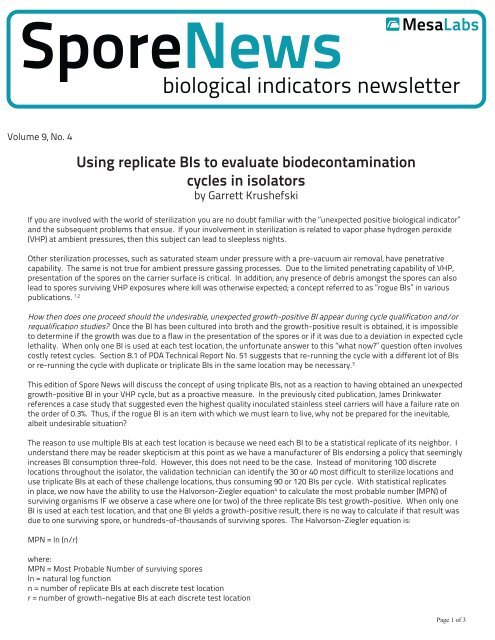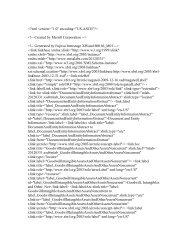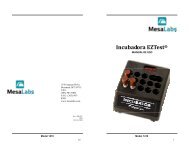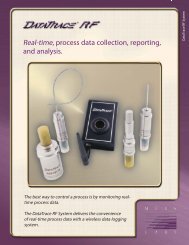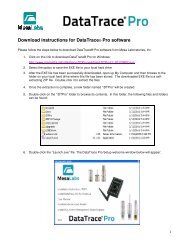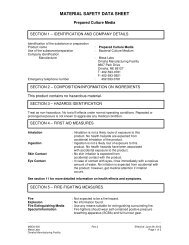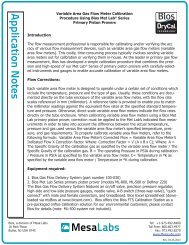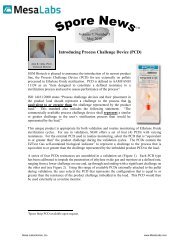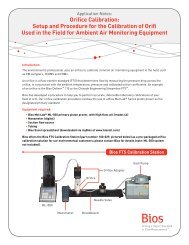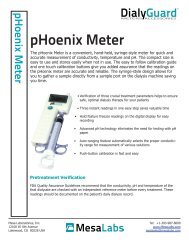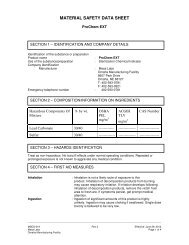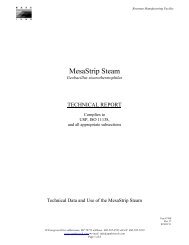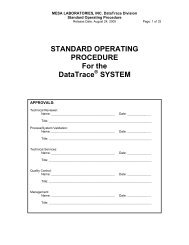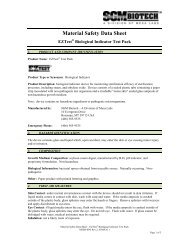Using replicate BIs to evaluate biodecontamination ... - Mesa Labs
Using replicate BIs to evaluate biodecontamination ... - Mesa Labs
Using replicate BIs to evaluate biodecontamination ... - Mesa Labs
You also want an ePaper? Increase the reach of your titles
YUMPU automatically turns print PDFs into web optimized ePapers that Google loves.
Let us look at an example of how we would proceed if in a VHP cycle we observed one positive and two negative <strong>BIs</strong> (i.e. n = 3and r = 2) at a particular location where triplicate <strong>BIs</strong> were used.MPN = ln (3/2) = 0.405What this MPN number indicates is that on average we have 0.405 surviving spores per BI. Two of the three <strong>BIs</strong> weregrowth-negative and thus we know that there were zero surviving spores on each of those two <strong>BIs</strong>. Now that we’vecalculated the MPN value, the next step is <strong>to</strong> use this number <strong>to</strong> calculate the spore log reduction (SLR) associated with thisobservation of two negative <strong>BIs</strong> and one positive BI. For this we have the following equation:SLR = Log 10No – Log 10MPNwhere:SLR = spore log reductionNo = the initial spore population on the non-exposed BIIf the Certificate of Analysis for the lot of <strong>BIs</strong> used indicated an initial spore population of 1.6 x 10 6 spores per BI, the SLRcalculation would be:SLR = Log 101.6 x 10 6 – Log 100.405SLR = 6.204 – (-0.393)SLR = 6.597Thus, one can see that despite the one growth-positive BI at the location of the triplicate <strong>BIs</strong>, one can still document that a 6+spore log reduction was achieved at that particular test location. Do be advised that this calculation is ONLY possible when<strong>replicate</strong> <strong>BIs</strong> are used. If one were <strong>to</strong> distribute 100 <strong>BIs</strong> at 100 discrete test locations, it would not be appropriate <strong>to</strong> performthe above MPN & SLR calculation as these 100 individual <strong>BIs</strong> are not <strong>replicate</strong>s of the others.The next question one might be tempted <strong>to</strong> ask is, Was that growth-positive BI due <strong>to</strong> an imperfection in the presentationof the spores…or was it due <strong>to</strong> a slight deviation in cycle lethality at that particular test location? Without intending <strong>to</strong>sound flippant, I suggest the answer <strong>to</strong> that particular question is, Does it matter? After all, we do have growth-negativeobservations at that location and the mathematical analysis demonstrates that a 6+ SLR was achieved. Granted, if all threeof the <strong>replicate</strong>s are growth-positive, or if one is routinely observing multiple positive <strong>BIs</strong> at multiple locations over manydays of testing, then we must consider that there is a true process deficiency in need of attention. But on the contrary, if oneis using the triplicate BI approach and is regularly seeing zero positive <strong>BIs</strong> at all test locations and an unexpected positivedoes appear, the above analysis should allow the cycle <strong>to</strong> be passed, regardless of the true cause of the growth-positiveresult.Adopting the <strong>replicate</strong> BI approach as your standard, everyday methodology is somewhat analogous <strong>to</strong> carrying carinsurance. No one ever intends <strong>to</strong> be involved in an au<strong>to</strong> accident, nor do we develop processes where we expect <strong>to</strong> routinelyobserve growth-positive results. <strong>Using</strong> triplicate <strong>BIs</strong> every day (as opposed <strong>to</strong> only in reaction/investigation) is preparationfor the inevitable. If a growth-positive BI does show up, we are already prepared with the statistical analysis <strong>to</strong> <strong>evaluate</strong>the situation and no expensive retesting or revalidation will be needed <strong>to</strong> address this one, unexpected, potentially rogue,growth-positive biological indica<strong>to</strong>r.US his<strong>to</strong>rical figure Benjamin Franklin is credited with coining the phrase, “‘an ounce of prevention is worth a pound of cure.’’In this scenario, every day use of triplicate <strong>BIs</strong> in your VHP cycle is that ‘‘ounce of prevention’’.About the author:Garrett Krushefski is the Manager of International Sales for <strong>Mesa</strong> <strong>Labs</strong>. In his twelve years at the Bozeman,Montana location, Mr. Krushefski began his work in the biological indica<strong>to</strong>r production labora<strong>to</strong>ry, later becamethe Supervisor and eventually the Labora<strong>to</strong>ry Manager. Most recently he provided technical assistance andguidance <strong>to</strong> cus<strong>to</strong>mers with respect <strong>to</strong> sterilization and the proper application of biological indica<strong>to</strong>rs as theScientific & Technical Services Manager.Mr. Krushefski is a committee member and active participant with the Association for the Advancement ofMedical Instrumentation (AAMI) in both the Biological Indica<strong>to</strong>r and Resis<strong>to</strong>meter working groups.Mr. Krushefski holds a B.A. in Biology from The University of Texas at Austin.Page 2 of 3
1.Drinkwater J, Chewins J, Steele G. Biological indica<strong>to</strong>rs don’t lie, but in sporicidal gassing disinfection cycles do they sometimes confuse thetruth? European Journal of Parenteral & Pharmaceutical Sciences 2009; 14(1): 5-11.2.Temple<strong>to</strong>n P, Hillebrand J. Case Study: Isola<strong>to</strong>r Sanitisation Cycle Development, Validation and Revalidation.3.Technical Report No. 51 Biological Indica<strong>to</strong>rs for Gas and Vapor-Phase Decontamination Processes: Specification, Manufacture, Controland Use, Parenteral Drug Association: Bethesda, MD, 2010.4.Halvorson H, Ziegler N. Journal of Bacteriology 1933; 25, 101-121Page 3 of 3


